1957-1963
Learning electronics from Eric Zepler, by Greville Bloodworth
1957-58 Postgraduate Diploma in Electronics
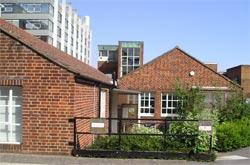 When I joined the Postgraduate Diploma course in October 1957 I knew very little about electronics, having studied physics at Oxford University and then worked on mechanical systems at Supermarine for four years.
When I joined the Postgraduate Diploma course in October 1957 I knew very little about electronics, having studied physics at Oxford University and then worked on mechanical systems at Supermarine for four years.
At Southampton University I was sponsored by that firm, but unfortunately it closed while I was taking the course. There were 18 graduates in the class. The west wing of the Physics Building, which is shown here in a recent photograph, accommodated our classroom and our laboratory.
Eric Zepler taught us circuit theory, and how to design amplifiers and radio receivers using thermionic valves. His teaching is described on another webpage.
Wally Punnett taught us about the use of feedback in amplifiers and control systems.
Bryan Venning taught us about pulse circuits and digital circuits, mostly using thermionic valves but some using transistors.
David Ingram taught us about small-signal germanium transistor amplifiers.
Nearly all of the practical work in the laboratory was on thermionic valve circuits. We needed to be careful not to touch components that were at high voltages or high temperatures!
This was undoubtedly a challenging course, which exercised our minds and gave us a good understanding of circuit design using thermionic valves. Unfortunately, the curtain was about to fall on that activity. Silicon transistors were going to take the stage. After the course, fortunately I was able to start work on the applications of silicon transistors at Mullards in Southampton. A year later I was back again, teaching the course.
1957-58 Eric Zepler’s Teaching
Eric Zepler taught with chalk and talk, backed up by laboratory experiments. With only 18 students in the Postgraduate Diploma class in 1957-8 there was an informal interactive atmosphere in the classroom.
He welcomed questions, both trivial and challenging. In response to the latter type his eyes would narrow and his face would freeze while he contemplated possible answers; then he would respond with a diagram or some mathematics that we could all understand. We saw that good circuit design depends on an intuitive understanding of how electronic components and circuits operate. A good knowledge of circuit theory is necessary. The creative steps in a design must be followed by mathematical analysis of the proposed circuit before construction is undertaken. Remember his crucial words in 1925: “that can be calculated”.
The coverage of his course may be summarised as follows.
- Circuit theory including loop and nodal analysis. Steady state and transient responses.
- Electronic components including thermionic valves and transformers.
- Small-signal, Class A and Class B amplifier circuits. Distortion.
- Amplitude and frequency modulation. Circuits used for detection and frequency changing.
- Antennas and radio systems. Gain control.
- Shot noise, thermal noise and current noise.
- Screening and undesired feedback.
In his laboratory classes Eric Zepler would soon find out whether we knew what we were doing, by shrewd questions and gentle coaxing. Many things were difficult, and he never pretended that they were easy. He helped us to develop our insight into the operation of circuits by encouraging us to sketch currents and voltages as functions of time and frequency, and to compare measured results with theoretical predictions.
1958-59 Silicon Bipolar Transistors at Mullards
After completing the Postgraduate Diploma course I went to work for Mullards (a subsidiary of Philips) at Millbrook in Southampton, where the development and production of semiconductor components were concentrated. Germanium bipolar transistors were manufactured for use in products such as portable radios. Compared with thermionic valve radios, transistor radios were small and lightweight, and they also had the nice feature that they produced sound as soon as they were switched on!
The manufacture of discrete silicon bipolar transistors had just started at Millbrook, and I investigated some of their possible applications. Because they could be operated with maximum internal temperatures of about 150°C, compared with only about 70°C for germanium transistors, they could operate at higher ambient temperatures and/or with higher power dissipations. To illustrate that, I made a medium wave radio using silicon transistors that operated in an enclosure at an ambient temperature of 100°C, and demonstrated it at the London Radio Show in 1959.
That radio was deliberately made with the same superheterodyne circuit arrangement as radios that already used germanium transistors from Mullards, so that it would be familiar to radio manufacturers. The first transistor was operated as a self-oscillating RF (radio frequency) mixer, and the second one as an IF (intermediate frequency) amplifier, which was followed by a diode detector and then the audio stage. The mixer stage was difficult to design (without a computer) because it amplified as a small-signal common-emitter amplifier and also had transformer coupling from the collector circuit to the emitter circuit to generate a large-signal (non-linear) oscillation. It was not easy to choose the turns ratio for the transformer. Eric Zepler would have said “that can be calculated”. When I had calculated it, and had operated the circuit successfully, I asked a man who had worked on the design of germanium transistor radios with similar circuits how the corresponding turns ratio had been calculated. “Calculated?” he said, “we could not calculate it – we used trial and error”.
Having said that, I must emphasise that there were some first-class engineers in the room where I worked at Mullards. On my right-hand side was Barrie Gilbert, a promising young man who in later life was to become one of the leading designers of analogue integrated circuits in the USA. On my left-hand side was Henri Kemhadjian, who was to follow me to Southampton University in 1964, where I became a Lecturer in Electronics in October 1959.
1959 Joining Eric Zepler’s Staff
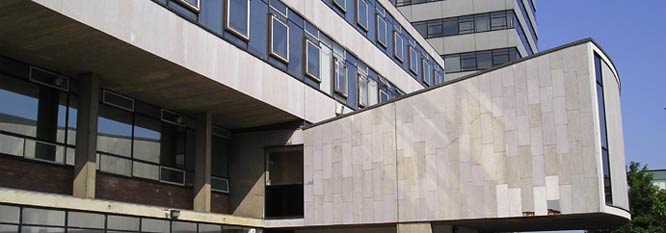
In 1956 the architect Basil Spence was appointed by Southampton University to design several new buildings, including the Lanchester building and the Faraday building. When the Lanchester building opened in the summer of 1959 the Department of Electronics moved into it from the Physics Building, taking over the top floor for teaching and research laboratories. The next floor down was occupied by academic staff from Electronics and from other engineering departments.
When I joined the staff in October that year I moved into a small room that remained unoccupied at the end of the long corridor near the lifts. Eric Zepler asked me to teach solid-state devices and analogue transistor circuits. Bryan Venning was increasing his teaching of digital transistor circuits. We had 8 first-year students taking the new BSc course in Electronics, 6 third-year students taking the BSc (Eng) course in Electronic Engineering and 15 Postgraduate Diploma students. I needed to generate laboratory work and projects in my subject areas for all of these groups of students.
One project that I arranged was for a third year student to investigate the use of discrete silicon bipolar transistors in radio frequency amplifiers. In particular, he studied a technique for neutralising the internal feedback in a common emitter transistor through the capacitance from the collector to the base, by using external feedback to compensate for it. Eric Zepler was very interested in this technique, which puzzled me slightly at the time. Later I discovered that he had used a similar technique in 1927 in the Telefunken T9W radio receiver, to neutralise feedback through the capacitance from the anode to the control grid in triode valves. In later years the introduction of a screen grid between the anode and the control grid had obviated the need for external neutralisation. Bipolar transistors could not be fitted with screen grids!
1959-63 The Genesis of Microelectronics
Between 1959 and 1963 I was working with Eric Zepler as a lecturer in the Department of Electronics. During those four years there were remarkable developments in solid-state electronics around the world. Microelectronics had arrived.
In 1959 discrete silicon bipolar transistors were being manufactured, and in that year Robert Noyce of Fairchild Semiconductor made the first transistor circuits that were integrated on single silicon chips. At that time the descriptions used for small circuit assemblies were miniaturisation and microminiaturisation. Such long words seemed to be inappropriate for such small things!
By 1963 the word microelectronics had come into widespread use. Silicon bipolar integrated circuits were being manufactured, both analogue and digital. In that year an important book entitled Microelectronics, edited by Edward Keonjian, was published by McGraw-Hill. It is available in the Hartley Library. In that book leading industrial engineers described their work on the miniaturisation of circuits. Out of 377 pages altogether, 97 were devoted to the chapter on Semiconductor Integrated Circuits written by Gordon Moore of Fairchild Semiconductor (later he was one of the founders of Intel with Robert Noyce).
In that chapter Moore devoted nearly all of the pages to the fabrication, structure and operation of integrated circuits, analogue and digital, that used silicon bipolar transistors. In the pages devoted to digital circuits he described how NAND and NOR functions could be provided by various configurations, and how such micrologic elements could be integrated in silicon to make a shift register, for example. Although only two pages were devoted to field-effect transistors, both unipolar (junction gate) and surface controlled (insulated gate) types, and the terminology MOS was not mentioned, Moore wrote that “the future of such surface-controlled structures looks extremely interesting”. While that book was being published intensive research work on MOS transistors had begun, because those devices offered the prospects of low-power operation and large-scale integration if the electronic properties of the interface between the silicon substrate and the insulating oxide under the gate electrode of each transistor could be understood and controlled.
In 1959, when we launched the first BSc course in Electronics in Britain, it was difficult to predict the advances that might be made in solid-state electronics in subsequent years. However, by enabling our students to acquire a good understanding of the physical operation of solid-state devices, and of the principles of circuit design, we could prepare them to participate successfully in the microelectronics revolution after they graduated.
1960-61 Deputising for Eric Zepler
Teaching
By September 1960 I had planned my teaching work for the coming session, when we would have second year students in the BSc course in Electronics. Also I should be able to start research, albeit part-time, an experience that I had never had before. There was no space for experimental work in microelectronics, but I could work in my office. Then bad news came.
Eric Zepler had been taken ill, and was unlikely to return to work before term started in October. I volunteered to teach his classes in addition to my own. It was the obvious thing to do, because I had attended his Diploma classes in 1957-8. I assumed that he would be back at work in a week or two, or three, or four…….and so his absence went on, for the whole of the academic year. My work in that year was certainly challenging, because his teaching was so highly regarded.
Undergraduate Admissions
During that year I also assumed responsibility for undergraduate admissions. When Eric Zepler returned we worked together on that activity. He cared deeply about young students. Some applicants were interviewed by both of us together, and I remember how gently he questioned them.
Undoubtedly our new BSc course was very popular because other universities were offering degree courses in Electrical and Electronic Engineering that did not concentrate so strongly on electronics, especially solid-state electronics. After Eric Zepler retired in 1963 I continued to be responsible for undergraduate admissions for many years. The admission process became easier when the national clearing house system was introduced in 1964-5, because it imposed a limit on the number of universities that each student could apply to.
Following the publication of the Robbins Report in 1963 the government gave university departments an opportunity to expand. We were able to enrol considerably more students in our department while maintaining high standards, in response to increased numbers of well qualified applicants.
1963 Books written by the Electronics Department
The following two books were written by the academic staff of the department and were published by Blackie in 1963. They show some of the material that we were teaching before then. Both books were edited by Zepler and Punnett. The headings of the chapters are given below, with the names of their authors. These books are available in the Hartley Library.
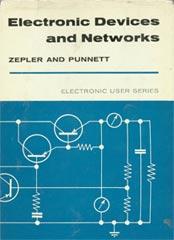 |
1 | Electron theory | E V Vernon |
| 2 | Network theory | H S Stachera | |
| 3 | Vacuum valves | W A Gambling | |
| 4 | Gas-filled valves | W A Gambling | |
| 5 | Transistor characteristics | G G Bloodworth | |
| 6 | Transistor circuit | G G Bloodworth | |
| 7 | Noise | E E Zepler | |
| 8 | Complete measuring system | S W Punnett |
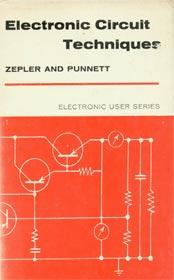 |
1 | Introduction | S W Punnett |
| 2 | Feedback systems | S W Punnett | |
| 3 | Audio & video amplifiers & oscillators | S W Punnett | |
| 4 | Low frequency amplifiers & oscillators | E E Zepler | |
| 5 | Radio frequency amplifiers & oscillators | E E Zepler | |
| 6 | Pulse circuits and waveform generation | B H Venning | |
| 7 | Modulation & demodulation processes | H Stachera | |
| 8 | Power supplies | S W Punnett | |
| 9 | Test equipment | S W Punnett |
1963 Space for Microelectronics Research
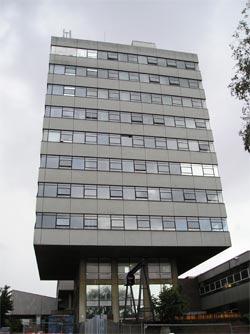 In the summer of 1961, having finished giving Eric Zepler’s courses, I was able to look forward to launching microelectronics research. Space would be needed for research students, technical staff and equipment. Fortunately, the construction was starting of a new tower block, mainly for the Departments of Electrical Engineering and Civil Engineering.
In the summer of 1961, having finished giving Eric Zepler’s courses, I was able to look forward to launching microelectronics research. Space would be needed for research students, technical staff and equipment. Fortunately, the construction was starting of a new tower block, mainly for the Departments of Electrical Engineering and Civil Engineering.
I was able to reserve some space on the top two floors for microelectronics laboratories and offices. In October 1961 Ken Nichols joined the department, and we then had a two-man Microelectronics Group.
The university’s architect had designed a building for the Chemistry Department that had its supporting structure on the outside. He then designed for the Engineering Departments a building that had its supporting structure hidden, for contrasting artistic effect. With cantilevered floors it would be very heavy, and it would be difficult to build because it was located on an old rubbish dump. After the construction work was delayed in 1963 by one of the coldest winters in the twentieth century, the building was completed in September that year. That was the month when Eric Zepler retired from our department.
At an Engineering Faculty Board meeting the Electrical Engineering Department proposed that the new building should be named the Maxwell Building, after James Clerk Maxwell who had formulated the basic equations of electromagnetism. The Dean of the Faculty was not keen on that proposal because he wondered whether some people might think that we had a link with the publisher Robert Maxwell! At that time books were being written for Maxwell’s firm by staff in many universities. At the next meeting of the Faculty Board it was decided that the building would be named after Faraday.
When our new Head of Department, Geoffrey Sims, visited us shortly before taking up his appointment in October 1963 he asked me to show him our rooms on the top two floors of the new building. When we found that the lifts were not working, he set off up the stairs at a fast pace, followed breathlessly by me. When I told Ken Nichols about this experience afterwards his eyes rolled upwards with disbelief. Clearly we were acquiring a vigorous new Head of Department!